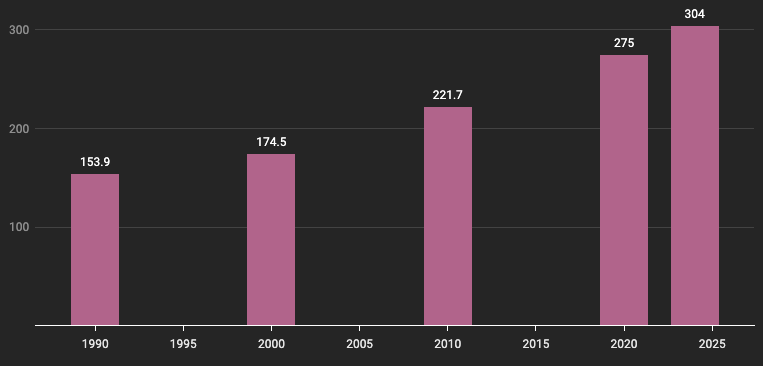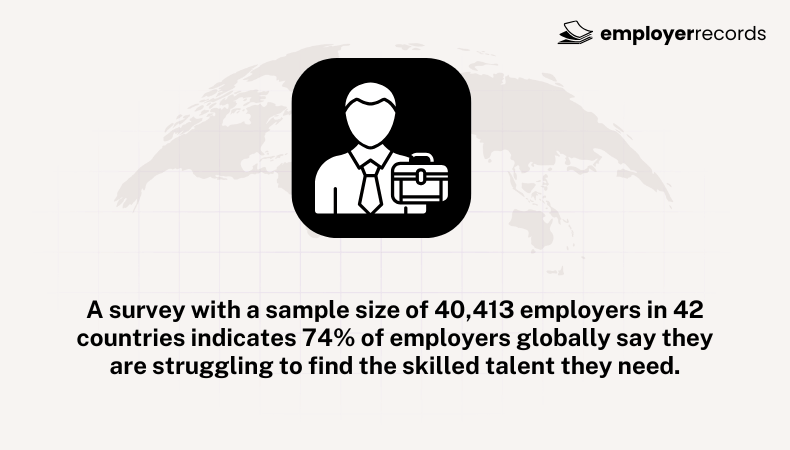Global talent mobility isn’t just about expats and relocation allowances anymore; it’s a snapshot of how organizations find skills, how people choose work, and where policy will need to catch up.
This article collects the clearest, verifiable numbers on that shift: who’s moving (and who isn’t), which forms of mobility are growing, and what those changes mean for HR teams trying to hire, develop, and retain talent.
Mercer and Cartus data show that overall mobility activity has largely held steady or, in many cases, increased, even as long-term expatriation plateaus and shorter, virtual or remote assignments rise.
You’ll also see why talent shortages, still flagged by employers in major surveys, are pushing firms to look beyond local labor pools, and why “e-migration” (people working for foreign employers while staying home) is suddenly part of strategic planning.
Read this as a tightly sourced guide: lots of short, verifiable stats with one-line context, plus a few practical pulls for leaders. No invented numbers, no fluff, just the data you can quote in a deck and the quick takeaways that help you act. If something looks surprising, the source link is right there for a deeper look.
Editor’s Choice: Quick Stats at a Glance
- Top talent hubs: BCG tracks 2.6 million highly skilled global movers, showing cities like London, Toronto, and Singapore as key magnets.
- Persistent shortages: 74% of employers continue to report hiring difficulties despite increased global movement.
- Rise of e-migration: Over 2.2 million professionals in Latin America now work remotely for international employers.
- Steady activity: 70% of organizations say their global mobility volume remained stable or grew in 2024 (Cartus).
- Changing models: Long-term expatriation is flattening, while short-term, hybrid, and virtual assignments are on the rise (Mercer, Deloitte).
Global Mobility and Migration Landscape
304 Million International Migrants (Mid-2024)
According to United Nations-derived data tracked by migration research hubs, the stock of individuals living outside their country of birth exceeded approximately 304 million by mid-2024.
This aggregate figure covers all forms of migration: work‐related, family‐linked, asylum or refugee flows, and marks a substantial rise compared to figures from earlier decades, although the share of the global population has grown more modestly.
The figure underscores the scale of human mobility beyond corporate assignments and frames the broader environment in which talent mobility occurs. Source: United Nations
Estimated number of international migrants (millions)

2.6 Million Highly Skilled Workers Relocated (BCG, 2025).
BCG’s Top Talent Tracker follows roughly 205 million highly skilled people and finds that about 2.6 million relocated across borders recently.
Within that moving cohort, roughly 727,000 were STEM professionals, and about 33,000 identified as AI specialists, mobility rates higher than the general skilled-worker pool.
The tracker highlights that tech and AI skills remain disproportionately mobile, concentrating in leading hubs and amplifying competition for those cities and firms that attract high-skill migrants. Source: BCG
Global Cross-Border Mobility of Highly Skilled Professionals, 2024 – 2025
| Category | Global relocations (12 months to Dec 2024) | Share of total tracked pool |
|---|---|---|
| Highly skilled (professionals with degree +) | 2,600,000 | 1.3 % |
| STEM professionals | 727,000 | 2.0 % |
| AI specialists | 33,000 | 2.4 % |
23% Actively Seeking Abroad; 21% Open To Relocation.
In the “Decoding Global Talent 2024” survey conducted by StepStone Group and partners, over 150,000 respondents across 188 countries indicated that 23 % are actively searching for jobs abroad, while roughly an additional 21 % remain passive but open to relocating.
The implication: nearly one-in-four professionals are mobility-ready now, with a much larger pool tuned to global possibilities.
For organizations planning a mobility strategy, this suggests an untapped reservoir of talent willing to move, not just those already in motion. Source: The Stepstone Group
Top Dream Job Locations: Australia, USA, Canada, UK, Germany.
According to the same StepStone survey, the countries most often cited as “dream destinations” for mobile professionals are Australia, the United States, Canada, the United Kingdom, and Germany.
These preferences appear repeatedly in respondent ranking data and correlate with factors such as English language prevalence, perceived economic opportunity, visa openness, and infrastructure.
For employers and mobility planners, the takeaway is that talent sees these nations as magnets, not only for relocation offers but for employer branding and candidate attraction. Source: The Stepstone Group
Changing Models of Mobility
Virtual, Short-Term, And Flexible Moves Are Rising (Mercer / Deloitte).
Surveys by both Mercer and Deloitte indicate a clear uptick in mobility types other than classic long‐term expatriation: virtual assignments, short-term placements, hybrid working across borders, and other flexible models.
These alternatives reduce cost, shorten disruption, and allow skills transfer without full relocation commitment. For mobility teams, adapting policies for this diversity of move types is increasingly a requirement, not an option. Source: Mercer Mobility Exchange
Only 18% Expect More Long-Term Assignments; 53% Expect Stability (Mercer).
According to Mercer’s 2025 outlook, only 18 % of mobility professionals anticipate an increase in long-term international assignments, while 53 % expect volumes to stay roughly the same.
This indicates a strategic shift: long-term moves may no longer be the dominant growth path. Shorter, modular, remote or hybrid alternatives appear set to fill the gap. Source: Mercer Mobility Exchange
| Assignment Type | % of respondents expecting increase | % expecting stable volume | % expecting decrease |
| Long-term international assignments | 18% | 53% | 16% |
Many Organizations Already Have International Remote Workers.
Cartus’s research highlights that a meaningful share of organizations now manage “international remote workers” or “local‐stay global contributors”, employees who work for global employers while remaining resident in their home country.
These arrangements add complexity around payroll, tax, benefits, and compliance. Mobility teams that ignore this shift risk being caught off-guard by the operational and regulatory demands of remote-international talent. Source: cartus.com
E-Migration Introduces Tax And Compliance Complexity.
The WEF highlights that e-migration, people working for foreign employers while remaining in their home country, creates thorny payroll, tax residency, and social security questions.
For global HR and finance teams, this means creating tracking mechanisms, working with local counsel, and often rethinking employment contracts to avoid inadvertent tax and employment law exposure. Compliance is now an operational necessity rather than a theoretical risk. Source: World Economic Forum
LinkedIn Shows Measurable Growth In Remote Roles (LinkedIn Economic Graph).
LinkedIn’s Economic Graph reports rising remote-role postings and shifting application patterns, especially among smaller firms and specific geographies.
Its September 2024 analysis documented incremental increases in remote hiring in several markets, giving empirical weight to anecdotal claims about the remote labor market.
For talent teams, platform signals like LinkedIn’s are a timely indicator of where remote hiring is gaining real traction. Source: Economic Graph
Organizational Mobility Strategy & Design
66% Programs In Mobility/Relocation; 20% In HR/Talent.
Research by Cartus in its 2024 Global Talent Mobility survey shows that about two-thirds (66 %) of organizations place their mobility programs under a dedicated “mobility or relocation” function, while approximately 20 % locate them within broader HR, talent, or people functions.
This organizational split suggests that many mobility teams still operate separately from core talent-management functions, which may affect integration with recruitment, leadership development, and talent-pipeline planning.
| Function/Ownership of Mobility Program | % of Respondents |
|---|---|
| Dedicated Mobility / Relocation function | 66% |
| Managed within HR / People / Talent | 20% |
| Other / Not specified | 14%* |
90% See Alignment Value; Only 30% Achieve It.
In a recent survey by EY, nine out of ten employers reported that global mobility should align with broader talent and business goals. Yet only about 30 % believe they are succeeding in doing so in practice.
The gap often stems from data silos, separate operating models, and a lack of early strategic input. The insight is that mobility remains a tactical activity in many firms rather than a strategic talent lever, even though organizations recognize its potential. Source: EY
70% Report Mobility Volume Increased Or Remained Stable (Cartus).
Based on Cartus’s 2024 findings, approximately 70 % of organizations say their global mobility volume either increased or remained stable in recent periods.
While that may not signal dramatic growth everywhere, it underlines that mobility remains active and relevant, even amid cost pressures and macro uncertainty. Programs that treat mobility as a shrinking function may need to reassess. Source: cartus.com
44% Report Increases; 40% Report Declines.
Drilling into large relocation programs in Cartus’s dataset reveals that 44 % reported volume increases, whereas 40 % reported declines.
The divergence points to uneven mobility outcomes, some organizations expanding as part of growth or capability building, others retrenching due to cost control or strategy shifts. The insight: mobility is not uniformly scaling; these differences matter for benchmarking.
Suggested Table for Use
| Program Size Category | % Reporting Increase | % Reporting Decrease | % Reporting No Change* |
|---|---|---|---|
| Large Relocation Programs (>500 moves/year) | 47% | 40% | Approx13% |
| Full Survey Respondents (all sizes) | 44% | Approx 26 | Approx 30% |
80% Engage In Intra-Country Moves; Most Have Policies (Cartus).
Cartus reports that around 80% of organizations manage intra-country (domestic) moves, and roughly three-quarters of that group have formal policies.
Domestic mobility is an often-overlooked lever for staffing and retention: it supports career mobility, fills regional skills gaps, and can be less costly than international moves.
Treat internal relocations seriously, and you get more flexible staffing without the complexities of cross-border compliance. Source: Contentful
Costs, Compliance, and Risk Management
Cost Control And Productivity Are Top Mobility Priorities For 2025 (Mercer).
Mercer’s 2025 outlook finds mobility teams under pressure to control costs while maintaining value. That drives policy segmentation (tiered benefits), location-based allowances, and pilots for lump-sum or short-term models.
The objective is clear: avoid blanket cuts that harm retention, while engineering choices that reduce unpredictable spend and align with business needs. Source: Mercer Mobility Exchange
Large Programs Tailor Lump-Sum Benefits By Level/Region To Control Costs (Cartus).
Cartus finds big relocation programs increasingly segment benefits; using lump sums, location-based allowances, or differentiated packages by role level, to contain spend while keeping mobility options open.
The approach preserves mobility for critical roles but removes blanket, expensive entitlements where they aren’t needed. It’s a pragmatic compromise: maintain strategic moves, trim indiscriminate spending, and keep candidate experience acceptable. Source: Contentful
Strategic Outcomes and Business Impact
Remittances Remain Significant, Hundreds Of Billions USD Annually (World Bank).
World Bank data show remittance flows to low- and middle-income countries running in the hundreds of billions of dollars annually (estimates around $650-685bn in recent years).
Those flows matter to mobility conversations because worker movement affects household incomes, local economies, and the political conversations that shape migration policy. Employers should consider the broader economic footprint of their mobility programs in origin communities. Source: World Bank
Over 50% Of Mobility Leaders Report Positive Impact On Retention And Outcomes (Cartus).
More than half of mobility-program leaders in Cartus’s surveys say that mobility contributes positively to business outcomes such as employee retention, leadership development, and global market understanding.
This data helps shift the narrative of mobility from a cost-center to a strategic value-maker, and supports investment cases for mobility features beyond logistics. Source: cartus.com
Evolved Mobility Models Achieve Better Talent Outcomes (EY).
EY’s research finds that organizations that modernize their mobility programs, aligning policy, data, and operations, are more effective at filling talent gaps, deploying critical capability globally, and linking mobility to strategic workforce planning.
In short, when mobility isn’t just about moving people but about moving strategy, outcomes improve. Source: EY
74% Of Employers Struggle To Find Skilled Talent.
ManpowerGroup’s talent shortage research consistently shows that a large majority of companies report difficulty hiring skilled workers.
That pressure is a core reason mobility remains strategic: if you cannot find skills locally, moving or sourcing talent internationally becomes a practical route to fill critical roles. Mobility, then, is not just a perk but a necessary component of many firms’ talent strategies. Source: go.manpowergroup.com

Employers Increasingly Treat Mobility As A Strategic Talent Lever (Deloitte).
Deloitte’s Global Talent Mobility work notes a mindset shift: mobility is being discussed in workforce planning, critical roles mapping, and leadership pipelines.
Firms are moving beyond logistics to ask where movement of people unlocks markets, skills, or faster product delivery. Yet many still lack the capabilities (data, governance, tech) to execute on that ambition, leaving an implementation gap to close. Source: Deloitte
Broader Economic and Human Context
2.2M+ Latin American Remote Workers Served Global Employers In 2023 (WEF).
WEF analysis points to over 2.2 million remote workers in Brazil, Argentina, and Mexico working for foreign companies in 2023, a concrete example of e-migration scaling.
That population changes sourcing calculus: employers can tap skilled talent without relocation costs, but must manage cross-jurisdictional HR, payroll, and benefits issues.
For businesses, it’s both an opportunity and a governance headache. Source: World Economic Forum
Migration Routes Remain Deadly; Thousands Die Or Go Missing (Iom / Reuters).
Beyond corporate mobility lies a stark human reality: IOM’s Missing Migrants Project and UN reporting show thousands die or go missing each year while attempting migration, with 2023 and 2024 among the deadliest periods on record.
Those figures remind HR and policy people that talent mobility sits within a broader, often perilous global migration landscape, and that humane policy, safe pathways, and ethical sourcing matter. Source: International Organization for Migration
OECD Talent Attractiveness Tracks Countries’ Pull Factors.
The OECD’s 2023 Talent Attractiveness tool benchmarks countries on factors that matter to high-skill migrants: job opportunities, income, family environment, and quality of life.
Governments use these indicators to design visas and retention measures; employers use them to think about location strategy and which markets will reliably supply experienced talent.
The dataset is a practical playbook for country selection and policy monitoring. Source: OECD
BCG’s Top Talent Hubs Show Concentrated High-Skill Flows.
BCG’s Top Talent Tracker maps flows among over 205 million highly skilled workers and finds that a concentrated set of cities and countries captures the lion’s share of talent movements.
That concentration matters strategically: winning a share of that traffic requires concerted employer branding, visa navigation, and local ecosystem support, and explains why some hubs outcompete others for high-value hires. Source: BCG Web Assets
Mobility Supports Reskilling And Leadership Pipelines.
WEF and Deloitte highlight mobility as a deliberate tool for capability transfer and leadership development: sending people into different markets or teams accelerates skill diffusion, creates promotion-ready leaders, and seeds new operations.
Rather than being purely transactional, well-designed moves are investments in capability, shortening the time needed to build local expertise versus hiring and training in place. Source: World Economic Forum Reports
Conclusion
Global talent mobility isn’t a single problem to solve; it’s a set of choices organizations make about where and how they find skill. The numbers we’ve looked at show two steady facts: moves haven’t vanished, and the shape of moves is changing more shorter, virtual, or locally based arrangements alongside traditional postings.
That matters because talent shortages and competitive hubs force choices: pay more to win in a hot city, or redesign roles so location matters less.
The rise of “e-migration” proves you can tap global skills without moving people, but it also brings tax, payroll, and compliance headaches that organizations still under-prepare for.
So here’s the practical tack: stop treating mobility as paperwork. Treat it like a talent strategy, use shorter, clearer policy blocks for each move type, get basic dashboards in place, and pilot flexible options where compliance is manageable.
Do that, and mobility becomes an engine, not an expense.







